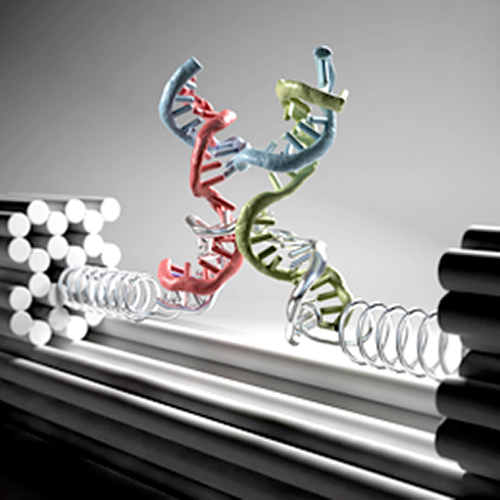



Business Inquiry
Global:
Email:marketing@medicilon.com
+1(781)535-1428(U.S.)
0044 7790 816 954 (Europe)
China:
Email: marketing@medicilon.com.cn
Tel: +86 (21) 5859-1500



In nanoscale dungeons, biomolecules are put on the rack, stretched until they divulge their mechanical properties, and whether or not they will continue to function as expected, even when subjected to structure-deforming stress. Unfortunately, nanoscale dungeons, like real dungeons, tend to be noisy places, which can confound analysis. Also, they are not terribly efficient. Microscale instruments of torture typically require a physical connection to the macroscopic world, and so they interrogate biomolecules just one at a time.

Yet torture at the biomolecular scale can be as creative as that at larger scales. Shunning instruments such as optical or molecular tweezers, scientists based at Ludwig-Maximilians-Universitaet (LMU) have instead resorted to DNA origami. These scientists, in collaboration with colleagues based at Technical University (TU) in Braunschweig and at Regensburg University, used single-stranded DNA molecules to fashion entropic springs that are capable of exerting controlled tension in the low piconewton range. Essentially, the scientists devised a new method of force spectroscopy that incorporates self-assembled nanoscopic power gauges, requires no macroscopic tools, and can analyze large numbers of molecules in parallel, which speeds up the process of data acquisition enormously.
Details of the work appeared October 21 in the journal Science, in an article entitled, “Molecular Force Spectroscopy with a DNA Origami–Based Nanoscopic Force Clamp.” The article describes how entropic springs may have different strengths, depending on the lengths of their constituent DNA strands, so as to apply more or less force. It also describes how the effects of the applied force may be assessed by taking advantage of the phenomenon known as Förster resonant energy transfer (FRET).
“FRET involves the transfer of energy between two fluorescent dyes and is strongly dependent on the distance between them.” explained Professor Philip Tinnefeld from TU Braunschweig. When the force applied to the test molecule is sufficient to deform it, the distance between the fluorescent markers changes and the magnitude of energy transfer serves as an exquisitely precise measure of the distortion of the test molecule on the nanometer scale.
Most important, the new method dispenses with the need for microscopic–macroscopic connections, such as the ones used to accomplish force microscopy or carry out methodologies based on optical or magnetic tweezers. In these established methods, the molecules under investigation are always directly connected to a macroscopic transducer. These methods require precise control of the position of an object—a sphere or a sharp metal tip on the order of a micrometer in size—that exerts a force on molecules that are anchored to that object.
In contrast, the new method can operate completely autonomously. And it can be used to study countless numbers of molecules simultaneously.
The DNA origami approach exploits the base-pairing properties of DNA for the construction of nanostructures from strands that fold up and pair locally in a manner determined by their nucleotide sequences. In the present case, the DNA sequences are programmed to interact with each other in such a way that the final structure is a molecular clamp that can be programmed to exert a defined force on a test molecule. To this end, a single-stranded DNA that contains a specific sequence capable of recruiting the molecule of interest spans from one arm of the clamp to the other. The applied force can then be tuned by changing the length of the single strand base by base.
“That is equivalent to stretching a spring ever so-o-o slightly,” said Philipp Nickels, a member of the LMU research group, which was led by Professor Tim Liedl. Indeed, by this means it is possible to apply extremely tiny forces between 1 and 15 piconewtons—comparable in magnitude to those that act on proteins and genes in cells. “In principle, we can capture any type of biomolecule with these clamps and investigate its physical properties,” added Liedl.
The researchers used the new technique to investigate the properties of the so-called TATA binding protein, an important gene regulator that binds to a specific upstream nucleotide sequence in genes and helps to trigger their expression. Essentially, they found that the TATA protein can no longer perform its normal function if its target sequence is subjected to a force of more than 6 piconewtons.
“We used the conformer switching of a Holliday junction as a benchmark and studied the TATA-binding protein–induced bending of a DNA duplex under tension,” wrote the authors of the Science article. “The observed suppression of bending above 10 piconewtons provides further evidence of mechanosensitivity in gene regulation.”
The new technology has just made its debut. But since the clamps are minuscule and operate autonomously, it may well be possible in the future to use them to study molecular processes in living cells in real time.
 Relevant
news
Relevant
news